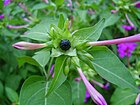Note: This is a project under development. The articles on this wiki are just being initiated and broadly incomplete. You can Help creating new pages.
Mirabilis jalapa
Mirabilis jalapa is the marvel of Peru or four o'clock flower. It is the most commonly grown ornamental species of Mirabilis plant. It is available in a range of colours. Mirabilis in Latin means wonderful and Jalapa is the state capital of Veracruz in México. Mirabilis jalapa was cultivated by the Aztecs for medicinal and ornamental purposes. This plant is belongs to Nyctaginaceae family.
Uses
Parts Used
Chemical Composition
Bioassay-guided fractionation of the methanolic extract of M. jalapa also led to the isolation of an active polyphenolic amide.[1]
Common names
| Language | Common name |
|---|---|
| Kannada | Gulamaji, Naalku ghante hoo |
| Hindi | Gul abbas, Gulbakshi |
| Malayalam | Anthimalari, Anti-mantaram, naalu mani poovu |
| Tamil | Pattarashu, Andhi Mandarai |
| Telugu | Chandrakantha, Chandramalli |
| Marathi | NA |
| Gujarathi | NA |
| Punjabi | NA |
| Kashmiri | NA |
| Sanskrit | Krishnakeli |
| English | Four O'clock, Beauty-of-the-night, Marvel of Peru |
.[2]
Properties
Reference: Dravya - Substance, Rasa - Taste, Guna - Qualities, Veerya - Potency, Vipaka - Post-digesion effect, Karma - Pharmacological activity, Prabhava - Therepeutics.
Dravya
Rasa
Guna
Veerya
Vipaka
Karma
Prabhava
Habit
Identification
Leaf
| Kind | Shape | Feature |
|---|---|---|
| Simple | Elliptical | They have numerous branches and opposite, pointed leaves 2-4 in long. |
Flower
| Type | Size | Color and composition | Stamen | More information |
|---|---|---|---|---|
| Unisexual | Trumpet shaped, two inches long | Red, magenta, pink, yellow or white | Sometimes with more than one color on the same plant. Like Petunia, bicolored flowers can also be grown. |
Other features
List of Ayurvedic medicine in which the herb is used
Where to get the saplings
Mode of Propagation
How to plant/cultivate
It grows preferably in light soil, rich in humus and well draining, it is neutral side acidity (pH).[4]
Commonly seen growing in areas
Photo Gallery
References
- ↑ Chemical composition
- ↑ Karnataka Aushadhiya Sasyagalu By Dr.Maagadi R Gurudeva, Page no:327
- ↑ Identification
- ↑ Cultivation
External Links
- Ayurvedic Herbs known to be helpful to treat Dropsy
- Herbs with Leaves used in medicine
- Herbs with Roots used in medicine
- Herbs with common name in Kannada
- Herbs with common name in Hindi
- Herbs with common name in Malayalam
- Herbs with common name in Tamil
- Herbs with common name in Telugu
- Herbs with common name in Sanskrit
- Herbs with common name in English
- Habit - Herb
- Index of Plants which can be propagated by Seeds
- Herbs that are commonly seen in the region of Garden area
- Herbs that are commonly seen in the region of Mountain area
- Herbs
- Nyctaginaceae



